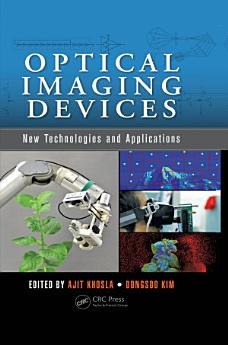Optical Imaging Devices: New Technologies and Applications
About this ebook
- Explains the physical principles of optical imaging and sensing
- Covers topics such as silicon-based imaging characteristics, nanophotonic phased arrays, thin-film sensors, label-free DNA sensors, and in vivo flow cytometry
- Presents the contributions of leading researchers, real-world examples from biomedicine, recommendations for further reading, and all measurements in SI units
Optical Imaging Devices: New Technologies and Applications provides an essential understanding of the design, operation, and practical applications of optical imaging and sensing systems, making it a handy reference for students and practitioners alike.
About the author
Ajit Khosla received his Ph.D from Simon Fraser University, Burnaby, British Columbia, Canada, where he was awarded the 2012 Dean of Graduate Studies Convocation Medal for his Ph.D research work on the development of novel micropatternable multifunctional nanocomposite materials for flexible nano- and micro-systems. He then served as a postdoctoral fellow at Concordia University, Montreal, Québec, Canada, and at the University of Calgary, Alberta, Canada. Since 2014, Dr. Khosla has been working toward establishing a nano-microsystem start up called Lab177 Inc. in Chatham, Ontario, Canada, with a focus on developing nano-microsystems in healthcare and flexible electronics. He is also a professor at the Soft & Wet Matter Engineering Lab (SWEL), Graduate School of Science and Engineering, Yamagata University, Japan, and a visiting scientist at the MEMS Research Lab, Department of Mechanical Engineering, College of Engineering, San Diego State University, California, USA. Dr. Khosla’s research work in the area of nano-microsystems has resulted in more than 100 scientific and academic contributions, and his work has been cited more than 250 times in the last three years. An active member in the scientific community, he is an executive and program committee member for two major conferences, including secretary for the Electrochemical Society (ECS): Sensor Division, and the Society of Photographic Instrumentation Engineers (SPIE): Smart Structures and Materials-Nondestructive Evaluation. Dr. Khosla has organized various Institute of Electrical and Electronics (IEEE) technical meetings, been lead organizer for two major conference tracks at ECS, and served as a Journal of The Electrochemical Society guest editor for focus issues on microfluidics, MEMS/NEMS sensors and devices, and nano-microsystems in healthcare. He is also an editor for accelerated publications of the Journal of Microelectronics Engineering.
Dongsoo Kim received his MS and Ph.D in electrical and electronics engineering from Yonsei University, Seoul, Korea. Currently, Dr. Kim works as a principal engineer at Samsung Electronics, Suwon, Korea. Previously, he was a senior engineer in the Wireless Communication Division at Samsung Electronics, a staff analog design engineer at Aptina Imaging, San Jose, California, USA, and a postdoctoral associate in the Department of Electrical Engineering at Yale University, New Haven, Connecticut, USA. His research interests include CMOS image sensors, smart sensors, low-noise circuit design, and biomedical instrumentation.





